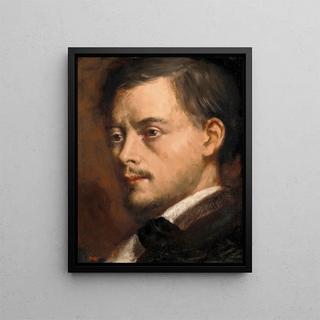Painting Head of a Man - Edgar Degas | Art print Source: Tableau Tête d'homme - Edgar Degas | Reproduction


View from behind

Frame (optional)
Edgar Degas's "Head of a Man" is a captivating artwork that immerses the viewer in the artist's intimate universe. Created at the end of the 19th century, this piece embodies Degas's innovative spirit, which moves away from academic conventions to explore more personal and introspective themes. The depiction of a male face, both classic and modern, evokes a deep reflection on identity and human expression. By contemplating this work, one is immediately transported into the vibrant world of the late Impressionist era, where emotion and technique meet with rare intensity.
Style and uniqueness of the work
The uniqueness of the "Head of a Man" lies in how Degas captures the very essence of his subject. The artist uses delicate strokes and subtle nuances to bring this face to life, revealing a psychological depth that goes far beyond simple representation. Shadows and lights intertwine, creating an atmosphere that is both mysterious and captivating. Degas does not merely depict a portrait; he infuses his work with a dynamic that invites contemplation. Each gaze upon this head of a man reveals new facets, as if the piece is in perpetual evolution. This distinctive style, blending realism and Impressionism, makes this work a true ode to the complexity of the human soul.
The artist and his influence
Edgar Degas, an emblematic figure of the Impressionist movement, is often recognized for his ability to capture movement and daily life. However, his work is not limited to these themes. With the "Head of a Man," he demonstrates exceptional mastery of portraiture, a field where he also left an indelible mark. Influenced by the masters of the past, Degas reinvents the genre by infusing it with modernity that sets him apart from his contemporaries. His bold approach and keen sense of observation have inspired many artists who followed him, making him a pillar of art history. The way he approaches the human figure and its emotions continues to resonate in the work of contemporary artists, testifying

Matte finish

View from behind

Frame (optional)
Edgar Degas's "Head of a Man" is a captivating artwork that immerses the viewer in the artist's intimate universe. Created at the end of the 19th century, this piece embodies Degas's innovative spirit, which moves away from academic conventions to explore more personal and introspective themes. The depiction of a male face, both classic and modern, evokes a deep reflection on identity and human expression. By contemplating this work, one is immediately transported into the vibrant world of the late Impressionist era, where emotion and technique meet with rare intensity.
Style and uniqueness of the work
The uniqueness of the "Head of a Man" lies in how Degas captures the very essence of his subject. The artist uses delicate strokes and subtle nuances to bring this face to life, revealing a psychological depth that goes far beyond simple representation. Shadows and lights intertwine, creating an atmosphere that is both mysterious and captivating. Degas does not merely depict a portrait; he infuses his work with a dynamic that invites contemplation. Each gaze upon this head of a man reveals new facets, as if the piece is in perpetual evolution. This distinctive style, blending realism and Impressionism, makes this work a true ode to the complexity of the human soul.
The artist and his influence
Edgar Degas, an emblematic figure of the Impressionist movement, is often recognized for his ability to capture movement and daily life. However, his work is not limited to these themes. With the "Head of a Man," he demonstrates exceptional mastery of portraiture, a field where he also left an indelible mark. Influenced by the masters of the past, Degas reinvents the genre by infusing it with modernity that sets him apart from his contemporaries. His bold approach and keen sense of observation have inspired many artists who followed him, making him a pillar of art history. The way he approaches the human figure and its emotions continues to resonate in the work of contemporary artists, testifying
12,34 €






